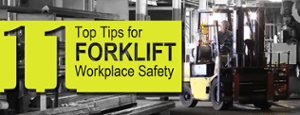Top 11 Tips for Forklift Workplace Safety
Stay Safe When Using a Forklift
Fork trucks are used in every type of facility. From fan factories to steel mills to aluminum fabrication plants. We come in contact with many different types of these forklifts and fork trucks on a daily basis. From electric forklifts to reach trucks to counterbalance forklifts, they are so common. So common in fact that it is easy to become complacent and forget just how dangerous they can be. That is why it is important to be aware of the hazards associated with lifts to ensure forklift workplace safety. Ensuring a sufficient amount of workplace safety could be as easy as completing something similar to this Work health and safety course Melbourne for maximum results. If workers are not trained in forklift safety or if employers fail to uphold health and safety regulations, they might find that their employee seeking help from someone similar to this construction injury attorney Gainesville who might help them with their case.
 Forklifts are extremely versatile machines. They have numerous uses in the factory setting; from loading/unloading equipment from flatbed trucks to repositioning equipment. They move heavy objects into relatively tight areas, quickly and seamlessly. A small forklift can weigh 10,000 lbs without the load, which is more than (2) Ford Explorer SUVs. Add a 3,000 lb load, and you can have a lot of momentum working for you . . . or against you.
Forklifts are extremely versatile machines. They have numerous uses in the factory setting; from loading/unloading equipment from flatbed trucks to repositioning equipment. They move heavy objects into relatively tight areas, quickly and seamlessly. A small forklift can weigh 10,000 lbs without the load, which is more than (2) Ford Explorer SUVs. Add a 3,000 lb load, and you can have a lot of momentum working for you . . . or against you.
Whenever you are working near operating forklift equipment, don’t assume the operator has you in sight. Let the operator know you are working in the area, or use a barrier to creating a safe zone. It is your responsibility to be noticed when working on fork trucks in a factory setting. Remember the fork trucks and lifts won’t get hurt if you run into it. Be responsible and be safe. Unfortunately, serious injuries do occur at the workplace, whether they are falls, being struck by objects or from machinery. For example, there are a number of causes of construction accidents in Charlotte, as well as many other areas or cities. Injuries happen all the time and if you know what to do following one, that is a step in the right direction.
For fork truck operators is important to always know where your load is and how it is reacting. Know where you are in proximity to other personnel and equipment and don’t forget the significant hazard of power lines/energized equipment. Regulations require the training of operators to be trained and certified every three years. New employees are required to be trained before they are allowed to operate lifting equipment.
Operators should consult a checklist to inspect critical lift equipment items before each use. This checklist needs to detail everything from the tires, tines, and brakes to the speedometer, horn, and lights. Making sure the equipment is in good working order is always step one in Forklift Workplace Safety.
Top 11 Tips for Forklift Operators
- Watch your hands and feet. Stay clear of pinch points such as the wheels and lift gears.
- Stay inside the machine within the guards. Keep hands and feet inside the fork lift.
- If your truck starts to tip over, DON’T JUMP! Stay in your seat, grip the wheel securely and brace yourself with your feet.
- Always look out for others when operating your fork lift.
- Never walk or stand under raised forks.
- Do not allow anyone to ride with you on a lift. Do not lift anyone on the forks unless using a basket made for that purpose.
- Be aware that hydraulic fluid can leak from a fork lift making the surrounding area slick. Prevent a slip and fall accident by inspecting the area.
- Absorbent mats are available to absorb leaks. Keep machines maintained to avoid this problem.
- Do not let unauthorized persons operate your lift and remove the key when unattended.
- Use your horn when backing up, at intersections, and when going through doors. Make yourself conspicuous anywhere you have limited or blocked vision.
- Use your seat belt and check that the warning lights and backup alarm work before operating the machine.
- Lastly, Do not exceed equipment load rating.
At Moffitt, we always say safety is Job One. Following these tips is just one more step to ensuring forklift workplace safety. Get more safety tips from Moffitt at our blog.
